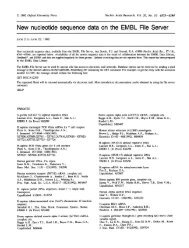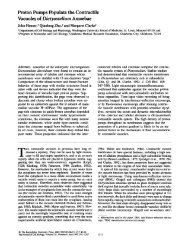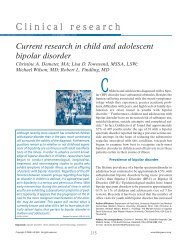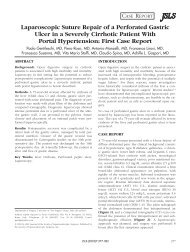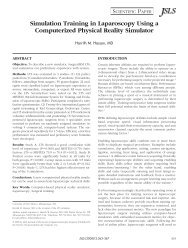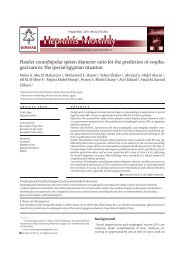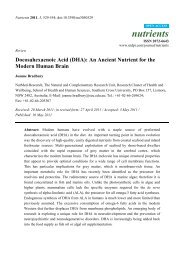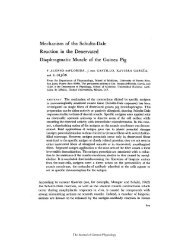Download PDF - BioMedSearch
Download PDF - BioMedSearch
Download PDF - BioMedSearch
You also want an ePaper? Increase the reach of your titles
YUMPU automatically turns print PDFs into web optimized ePapers that Google loves.
Volume 14 Number 2 1986 Nucleic Acids Research<br />
The complete codig sequence of the human raf oncogene and the corresponding structure of the<br />
c-raf-1 gene<br />
Tom I.Bonner, Hermann Oppermann1, Peter Seeburg1, Stephen B.Kerby2, Mark A.Gunnell2, Alice<br />
C.Young and Ulf R.Rapp3<br />
Laboratory of Cell Biology, National Institute of Mental Health, Bethesda, MD 20205, 'Department of<br />
Molecular Biology, Genentech Inc., South San Francisco, CA 94080, 2Program Resources Inc.,<br />
Frederick Cancer Research Facility, Frederick, MD 21701 and 3Laboratory of Viral Carcinogenesis,<br />
National Cancer Institute, Frederick, MD 21701, USA<br />
Received 21 October 1985; Revised 4 December 1985; Accepted 16 December 1985<br />
ABSTRACT<br />
The complete 648 amino acid sequence of the human raf oncogene was<br />
deduced from the 2977 nucleotide sequence of a fetal liver cDNA. The cDNA<br />
has been used to obtain clones which extend the human c-raf-1 locus by an<br />
additional 18.9 kb at the 5' end and contain all the remaining coding exons.<br />
INTRODUCTION<br />
Oncogenes are genes which have been identified because they cause cellular<br />
transformation either when naturally incorporated into a retrovirus or<br />
when introduced into tissue culture cells by transfection. Since these genes<br />
are evolutionarily well conserved, they are generally thought to have a normal<br />
role in the cell which is subverted by their reintroduction into the cell<br />
in a form which alters their function or regulation. A normal function has<br />
been identified for 3 of the approximately 25 known oncogenes. The erbB gene<br />
is derived from the receptor gene for epidermal growth factor (EGF) (1), the<br />
sis oncogene corresponds to a portion of the gene for platelet derived growth<br />
factor (PDGF) (2) and the fms gene product has been shown to be related to<br />
the CSF-1 receptor (3). The raf oncogene was originally isolated from a<br />
murine transforming retrovirus, 3611-MSV (4). Subsequently the mil (or mht)<br />
oncogene of the avian virus MH2 was identified as being the avian homologue<br />
of raf (5, 6). The deduced amino acid sequences of these oncogenes are<br />
distantly related to a number of oncogenes which encode tyrosine specific<br />
kinases, as well as others which apparently do not (6, 7). Although the<br />
viral raf and mil gene products do not have tyrosine specific. kinase activity,<br />
they have recently been shown to be associated with a serine-threoninespecific<br />
kinase (6, 8). We have recently reported that there are two human<br />
genes related to raf and mil (9). The functional gene, c-raf-1 contains<br />
eleven exons which are homologous to mil, nine of which are also homologous<br />
to raf. The second gene, c-raf-2, is a processed pseudogene. In order to<br />
© I R L Press Limited, Oxford, England. 1009
Nucleic Acids Research<br />
1010<br />
CC6 AAT 6t6 ACM C TCC CE tCC CTC ACC CE CAC KIN SA A CH El ISA AK TK CEC C6A C6 SI6I C61 TIN6S 66SC CT6 Et CCC<br />
ivon 2<br />
191<br />
TCA ST TtA AlA ATT TT TM 0CT CA TrC AT6 AM CA AlA CAl NA ACt TM N C6ATC C MT MT TTT ISA TTC MA SAT IC 6T6 TtT SAT<br />
NET 61 Aim [I ASin lv Al rep Lyi Thr IIe Sir Asn 6li Phi liv Phi Lvs Amp Aim Vil Phe A<br />
297<br />
SE ITC TEC ATC TCT CCT ACA A5 IOT CAl TEl TTT AK TAT CM CIC C66 EA TCA SAT SAT SE AAA CTC ACA SAT CCT TT SAlCA MC ASC<br />
Glv Sr Sr Cvi II* Sir Pro rhr lI Val 6ln 6Ai Phi Slv Tvr Oln Arg Arg Ali SAr Asp Asp 6lY Lvs Lw Thr Asp Pro Sir Lvi thr Air Aim<br />
*m33<br />
ACT AtC CST ITT TTC TT6 CC6 AAC AM CM 15CAITS OTC MT 6Il CIA MT 6IA All C ITS CAT 6AC TE CTI ITS AM SCA CTC AM 6TS A66<br />
Thr IA ak Val Phi Lou Pro As Lvi Oln Arg The VilVal Mm Val ArgAsg Ilh ET AIr Lou Aim Asp Cvs Lou Et Lvs Ala Lou Lvi Vil Arg<br />
lion 4<br />
ZC CTI CMA CC 6AI T1C tOT ACA 616 TIC MA CTT CTC CAC I CAC IN l I AM EA6 CE TTA 6AT TN AMT ACT SAT 6CT 6C6 TCT ITl AlT<br />
61v Leu Eln Pro Slu Cvs Cvs Al Val Phe krg Lt Lr His6il His Lvi ltv Lvi Lvs Ala rg Lu lAso Trp Asn Thr Ao AlA Ala Air Liu Ii<br />
Aiin 5<br />
A 594<br />
66NA AMSM CT CAt lTA 6A1 TIC CI6 SAT CAT OTT CCC CTC C C CAC AK TTT 6CT CM AM ACI TIC CT6 AM CTT 6CC TTC T6 SAC AITC TOY<br />
li61v 61 L6 o Oin Vai As Phi LuLAu Aim Vai Pro Lou Thr Thr His Asi Phi Ala Arg Lv Thr Phe Lou Lys Lw Al Phi Cvi Asp iii Cvs<br />
93<br />
CM SAA TTC CTI CTC MT AK TtT CBA IIT CM ACT TT AK T1C AMA TT CAT IN CAC TIt AK AC AM TA CC ACT Allt6 TIt 6T6 AC T6 MT<br />
Sin Lv Phi La Lw u ln y Phi Arg Cvi Oii TMr Cvi 6ly Tvr Lyi Ph Hii Aim His Cvi Sr thr Lvi Val Pro Thr NET Cy$ Vii Ap trp Ser<br />
i 792<br />
SC SIC SAG CM CiC TTA ITS TTI CCA MT ICC ACT ATT 6T SAT MT 6A 6TC CCA EA CtA CCT tCt T6 ACT ATl CST CSt All CI 6A6ICT SIT<br />
Asu [it Ark iv Lu Lu Lou Phi Pro Asn Sir Thr IIi liv Amp Sr Sli Vl Pro Al Lou Pro Sir Lou Thr NE rg Arq iET rg liu SAr Val<br />
miii 7<br />
TCC A66 ATl CCI 6ST AMl tCT CS CTAC S tAT TCt ACA CCt CAC 8C TTC CC TTt SAC C ICCMA6 CCC ?CA TCT 6A5 66T TCC CTC ICC CM SN6<br />
Si rqrgEt Pro Vii Aer Em Cin Kis ArS tvr Sr TSr Pro HAi Al Ph Thr Phi Ain TSr Sr Air Pro Sir SAr Biu Sly Sr Liu Sr Gin Arg<br />
mov 8<br />
CAl AK6TCT S TCC ACS CCT AAT 6SACTATO 5T1Ct A6C ACC AC6 CtI CCI Atll6CAK C IN Atl AlT N6SAT ES ST CIA MT CAC AC IN ICE<br />
Ein Ark Sir Thr Ser Thr Pro Asn ValHiiIIET E l Sr thr Thr Lou Pro vol A"m Sr Sri NET IIi Olv Asp Al [it Arg Sr His SAr Aim Sr<br />
miii 9<br />
ICC TCA CCI TCT ICC CtI tCC IT TAl C CCC KC MTCtS MC CCA ACA 6SC TNG TCA C6 CC AIC CCC 6T6 CCA SCT CAA AA I C6 ICA CCA<br />
Ala Sr Pro Sir Ala Liu Sir Sir Ser Pro s Aim Lou Ser Pro Thr Clv TrI Sr Blv Pro Lvi thr Pro Vil Pro Al Bln Arg 6lv Arg Aim Pro<br />
imi118 6TE TCt Il ICC CM6 IA6 AAA SAC AM ATT SN CCT CIT A CAB AA 6At ICA ABC TAT TAt T6N SAA AtA B1M ICC SIT I I6T6 At6 CI6 tCC ACT<br />
Val Sir liv Thr Oln Stu Lvs AEn Lvi [i Arg Pro Arg Slv Bi Arq sp Sr Sr 1rw Tvr trI 6lu lie 61u Ala Sr Clu Val NET Liu Ser Thr<br />
Aiim 11<br />
1287<br />
C66 ATT 616 TCA A6CK TtT tIA ACT OTT tAt AN 6I MS TM6 CAC K 6SAT All ICA 6tI IA ASC CIA AM Ott STC SAC CCA ACC CCE OA CAA<br />
Aro fit 6lv Sir 6lv SAr Phi 6ly Thr Val Tvr Lvi 61v LYv Trp Hi Sly As Vii Ala Vil Lvs Ile Lou Lvs Val Yal Asi Pro Thr Pro 61u 6ln<br />
mvoi 12<br />
TtC CM 6CC TTC AN SAT SA 616 Et STt CTI C6C A C tN TAT O5MC6I<br />
CII CIT TIC A IN t T1 A 5 AtAA ASM 6AC SAC CTI CCA ATT<br />
Ph 61n Alm Phe Ari Asn 6lu Vol Alm Val Lou kg Lvs thr Arg Nii Val Ain lie Liu Lou he ET liv Tyr ET Thr Lvi Asp Asn Lou Aim It<br />
1415<br />
It6 CC CAB I T6A6CSM AK AK CTC TAC AM CAC CtI CAT OtC CAB IN ACC AA5 tTt CM AT1 TTC Ct6 CtA ATt 6AC TTIIM CT 6CM K6<br />
Sal Thr Sin Try Cvs 6iv 6lv Sir Ser Lou Tvr Lvi His Lou Aim Vai 61n 6lu Thr Lvi Phi 6in NET Phi 61n Liu Ile Asi liiAim Ari 61n Thr<br />
emon 13 iRon 14<br />
s ~~~~~~~~~~~1514<br />
OCT CM 66A ATl 6A TAT Tt6 CAt ESKIAAS ASCAtC CIT AlA 6A All AMA TCC SAC Ml ATA TTTCCIT TAT 6M 6SE TTA ICE T6 AAA ATT NA<br />
Al 6in liv MET Ass Tvr Lf Ai EAl Avskn i IleI IliArg Aso AET Lvs Swr An Ain lie Phi Lou His 6lu Sly Lou Thr Vol Lys Ile 6ly<br />
mmii 15<br />
1413<br />
SAT tIt 66t TT6 ICA ACA 6tI AM TCI CE TIN ST NT TCT CAl CM OTT 6IN CAS cc ACT 6NC TCt 6TC CtC TN All ICC CCA EMS Ill ATC CTN<br />
Amp Phi 61i Lou Aim Thr Val Lvi Ser lrg trp SAr 6lv Swr Oln Bn Vol Olu lin Pro Thr l1v Sir Vil Lou Tro MEt AlS Pro fli Val IIi Arg<br />
1712<br />
ITS CAM SAT AKC AC CCA TIC Ut TtC CM TC6 SAT ITC TAC TCC TAT 6K ATC BtA Tt6 TAT IN CO STE C6 ON IN CIT CCt tAt TCT CAC AtC<br />
MET 6in Aso Asn Asu Pro Phi Ser Phi Gin SAr Aso Vl Tr Sr T1r 6lv Ie Val Lou Tvr 6lu Lou Et Thr Slv 6lu Lou Pro Tyr AfHis Ile<br />
evlon lb<br />
AAC AAC CTN 6AT CM6 TC ATC TtC AT6 0T6 OK CIA 6A tATI C ItCC CA 6AT CTT AMT AM CtA TAT IN AlTK CM AM ESA AT6 IN AK CTI<br />
Asn son kr Ap Bin fit [le he PhTE v l lv Arg Sly Tyr Al Sr Pro Amp La Sir Lys Lou Tyr Lys AS Cvi Pro Lyi Ala NET Lvs Ark Lou<br />
6T 6CE IAC TGT 6T6 AM AM 6TAIIAM 6A 6 A66 CCTTTTT CCC CM ATC CT tCT TMC ATT AA CT CTC CMC tCT CTAMC6T N TC<br />
.'&I Ala lo Cvs Val Lvm Ls Val Lvi livIluAmg Pro Lou Phi Pro Oln 1a Lwu Sr ir Il Ailm Lou Lw Sin Ais Sr Li Pro Lvi Ile An<br />
2179<br />
Ct AK ICTC IT TCCA IC II CAT CHT ACE CC CAC ACT IN AY SIT C tCTTE AC ICT C TCC TCCO A CIT MTI TI TXTTtI Il<br />
Arg Sr Aim Sr Btu fro Ur L NisArm Aim Al Nii Thr liv Asp Ile Ai la Cni TSr Lou Thr T r Pro Erg Li Pro V. Pil<br />
219<br />
ACTTTEACC tItCtTCAK CTECCAAM A66_AIM 6CCEEI ACCACITTTtC TITCCCTTt CTCCMK NIACATA T"TCAUI AKTCITKTA AIISTTCT<br />
231t<br />
ICTSCILv ClhCCtli SCIlCAts6t ICTICtIl LCTSTCCTTII NCICTCA AIASIE CAIIItAT ETUTITIT CCTITCCCt CCCCAtATTC CCACKITA<br />
IIICCCAKC ITCTIAKATACANIN ATITTIAIM TIIACMM NT C TA K tITTWAC AtI ATTt AIAIIAT 1ANT4 1 ITTAICT<br />
CIGATITAK SATACATATTTTIA ITACITTtI AIMIATAC TICTATIC A TMCT TCAIAIITI IICAITCC ACTMIt CATAAIK ECIAAA<br />
C 2679<br />
NITCK C TtCI ICCTICCEIN AtTI TIAI TAT MMT TTATIA_S CtCT`tT TCTA1C TAN AISTN ATM 1ATIIT<br />
2799<br />
CICI ACICTAE CCMICTC MTTCTtTA IIAE T ITITATIC T MtMt CTTCCIII CTrC TAIM USKETKAtIC C TITTIjCT<br />
AATMIT ACIASTAAC ATCTMTA CTTAITIC ATCATKtA tAC_111CCtITAC AMT11T 1ATUT1T 111AM1TT MTML<br />
AAATtW AtCTAM CCCXTCTA rTIffATM AT AT TTAA A AAWAA<br />
2915~~~~~~~~~~~~~31<br />
AMETIt AtCTTATUT CCTMITITAT TATTftA ITAMATMA ITITIA 11M1A1 TIETITTAC TCTMTMA NIAATTCTI AKTACAAC TTINT CT<br />
CATITITCA CMTtCTTCSA GATCAITIU
Nucleic Acids Research<br />
further characterize the raf gene and its protein product, we have cloned<br />
a human cDNA which contains all the coding sequence of the raf gene and<br />
have used this DNA as a probe to identify the remaining 5 coding exons of<br />
the c-raf-1 gene.<br />
MATERIALS AND METHODS<br />
Library Screening: Two human cDNA libraries, one derived from fetal<br />
liver mRNA (provided by E.F. Fritsch) and one from placental mRNA, in the<br />
XgtlO vector were screened using a raf-specific portion of the cloned<br />
3611-MSV virus (the 0.75 kb XhoI-SstII fragment) as probe (4). Filters were<br />
hybridized in 3X SSC at 60°C and washed at 1X SSC at 60C. Genomic clones<br />
were obtained by screening partial EcoRI and HaeIII-AluI libraries in Charon<br />
4A (10) using the 0.9 kb EcoRI-SalI fragment from the 5' end of the 2.9 kb<br />
liver cDNA clone.<br />
RESULTS<br />
Characterization of cDNA Clones<br />
Screening the fetal liver cDNA library with raf specific probe yielded<br />
two large clones (2.98 and 2.89 kb). These clones are only slightly smaller<br />
than the 3.4 kb raf message which has been observed in numerous tissues<br />
(J. Cleveland, personal communication) and contain the complete coding<br />
sequence. Similar but shorter clones were also isolated from the placental<br />
library. Upon analysis, two of the placental clones were found to contain<br />
intron as well as exon sequences.<br />
The sequence of the long liver cDNA clones, as shown in Figure 1,<br />
contains a single large open reading frame from nucleotides 121 to 2073<br />
followed by an untranslated region of 905 nucleotides which ends in a<br />
poly(A) stretch of 9 nucleotides. This poly(A) stretch is preceded by two<br />
AATAAA sequences which could serve as polyadenylation signals (11). To<br />
confirm that the apparent poly(A) sequence is not due to priming of the<br />
cDNA from an A-rich sequence of the gene, we have compared the cDNA sequence<br />
with the sequence of the corresponding region of the human c-raf-I gene.<br />
Figure 1. The nucleotide sequence of raf cDNA and the deduced amino acid<br />
sequence of the raf protein. The bottom two lines show the sequence of<br />
the 3' end of the human c-raf-1 gene (9) aligned with the 3' end of the<br />
cDNA. The EcoRI site in c-raf-1 is at 40.5 kb in Fig. 2. The presumptive<br />
ATP binding site is located near nucleotide 1200 and the majority of the<br />
amino acid homology with other kinases lies between nucleotides 1480 and<br />
1773. The first nucleotide of each exon is indicated by an asterisk above<br />
the sequence.<br />
1011
Nucleic Acids Research<br />
EcoRI<br />
Hindlil<br />
Xbal<br />
BamHl<br />
BgIIlI<br />
Sall<br />
Hpal<br />
Sphl<br />
EcoRV<br />
Sacl<br />
Kpnl<br />
Xhol<br />
X40 l1X2,,<br />
li<br />
2 70 3 6 7 8910 1112 13 14 17<br />
1516<br />
14.4 4.2 0.3 10.3 8.4 3.0 2.5 2.9<br />
2.2 3.1 2.5 0.7 f.0 0.9 1.2 3.4 3.25 7.5 3-5 1.8 1-8 6.8 0.7<br />
0.6 I~68 ,.<br />
1.4 3.1 3.3 0-5 5.2 2.0 0.4 5.4 2.9 2.6 3.3 9.6 6.2<br />
28.6 0.3 1.31.0 12.2 2.6<br />
1.2 7.5 5.5 11.4 2.5 11.0 2.1 4.8<br />
19.2 12.9 0.7 9.2 4.0<br />
__ I<br />
1.4 4.2 7.3 4.6 1.6 9.4 .1.4.1.5, 6.0 3.6 4.6<br />
3.0 14.0 10.4 1.9 1.3 5.9 9.4 0.2<br />
~~~~~~ I I<br />
1.5 2.3 4.7 19.6 5.3 1.9 1.4 2.9 6.5<br />
2.6 3.3 5.6 4.5 9.4 0-4 2.5 6.2 6.2 1.4 3.6 0.3<br />
I I :1 4 I I -<br />
37.7 4.5 0-6 2.3 0.9<br />
27.7 18.3<br />
0 4 8 12 16 20 24 28 32 36 40 44 48<br />
I1<br />
Figure 2. Restriction map of the human c-raf-1 locus derived from overlapping<br />
A phage clones. Clones X13 and X2 have been previously described (9).<br />
The positions of four phage clones and the exons which they contain are shown<br />
above the map. The 14.4, 10.3, and 8.4 kb EcoRI fragments but not the 3.0<br />
and 2.5 kb fragments hybridize to Alu family repeated sequences [BLUR8 (17)].<br />
The sequence alignment shown in Figure 1 demonstrates that the gene has the<br />
sequence AGGTGTAAT in place of the poly(A) and thus the poly(A) stretch of<br />
the clone represents the true poly(A) of the message. The 1953 nucleotide<br />
open reading frame is the only open reading frame of more than 280 nucleotides<br />
and coincides with the reading frame of the viral raf and mil proteins.<br />
Its sequence has been confirmed by sequencing the corresponding 16 exons<br />
of the human c-raf-1 gene (see below). The cDNA thus encodes the complete<br />
648 amino acid raf protein with a predicted molecular weight of 73023<br />
daltons. This result extends the amino terminal of the sequence known<br />
from v-mil by 267 amino acids. However, this additional sequence has no<br />
significant homology to protein sequences in the National Biomedical<br />
Research Foundation Protein Data Bank. As judged by the criterion of<br />
Kyte and Doolittle (12), the complete protein contains no extensive hydrophobic<br />
regions which would be candidates for transmembrane regions. This<br />
characteristic is consistent with the observation of a 75000 molecular<br />
weight raf protein primarily in the cytosolic fraction of normal rat<br />
cells (13).<br />
1012<br />
kb
Nucleic Acids Research<br />
Structure of the c-raf-1 Gene<br />
The availability of a nearly full length cDNA clone allowed us to<br />
extend the characterization of the 5' end of the c-raf-l gene beyond the<br />
region of homology to v-mil. Using the 5' portion of the cDNA as probe we<br />
have isolated two additional genomic clones, AHR40 and XHR70, from<br />
partial EcoRI and partial HaeIII-AluI libraries, respectively. These clones<br />
extend the 5' end of the restriction map of the locus by 18.9 kb (Fig. 2).<br />
The exons in these clones were located approximately by hybridization of<br />
cDNA probes to restriction digests of the clones and the appropriate regions<br />
were sequenced to precisely identify the exons. Five additional exons were<br />
identified which account for all the coding sequences. The intron boundaries<br />
all contain characteristic splice acceptor and splice donor sequences (13).<br />
Their positions have been indicated on the map of the genomic clones (Fig. 2)<br />
and the sequence of the cDNA (Fig. 1). The exon which contains the first<br />
103 nucleotides of the cDNA sequence is not contained within these clones.<br />
Although there are about 500 nucleotides of mRNA unaccounted for in the<br />
genomic clones, we have assumed for the purpose of numbering the exons that<br />
there is only one additional exon which contains all but 26 nucleotides of<br />
the 5' untranslated sequence. The structure of the gene has been confirmed<br />
by the detection of the expected bands in genomic blots of human DNA using<br />
the cDNA as probe (not shown).<br />
DISCUSSION<br />
We have characterized a nearly fully length cDNA which contains the<br />
entire coding sequence of the human raf oncogene. Taking advantage of the<br />
HgiAI site which spans the second and third codons of the coding sequence<br />
we have begun an attempt to express the complete protein in E. coli. If<br />
substantial amounts of protein can be produced it should be very useful in<br />
characterizing the function of the gene and in verifying that the raf<br />
protein is a serine-threonine specific kinase. The cDNA has also allowed us<br />
to identify all the coding exons of the human c-raf-1 gene. This informa-<br />
tion should be useful in characterizing rearrangements of the gene in human<br />
tumors. Five transforming variants of the raf gene have been described,<br />
all apparently being truncated at the amino end. The viral raf and mil<br />
sequences in the transforming viruses 3611-MSV and MH2 begin within exons<br />
9 and 7 of the mouse and chicken genes, respectively, and extend beyond the<br />
termination codon in exon 17. A promoter insertion activated form of the<br />
mouse gene has been described (14) in which a retroviral long terminal<br />
1013
Nucleic Acids Research<br />
repeat sequence was inserted between exons 5 and 6. In addition, two transforming<br />
raf DNAs have been identified by transfection of DNA derived from<br />
human humors (15, 16). In the first of these, obtained from a stomach tumor,<br />
the transforming DNA has been cloned and partially mapped with EcoRI and<br />
Bam HI. Comparison of the map of this DNA with Figure 2 indicates that the<br />
EcoRI site at 29.2 kb and the cluster of Bam sites at 28-32 kb (Fig. 2) is<br />
present. The 10.3 and 8.4 kb EcoRI fragments on either side of this site<br />
in our map agree well with the 10.0 and 8.0 kb fragments of the transforming<br />
DNA suggesting that exons 7-13 are present. However, the EcoRI site at<br />
40.6 kb (Fig. 2) is absent in the transforming DNA suggesting a rearrange-<br />
ment near the poly(A) site. The EcoRI fragment immediately 5' of the 10.0 kb<br />
fragment in the transforming DNA is a 13.0 kb fragment containing two Bam<br />
sites while our clones have 0.3, 4.2, and 14.4 kb EcoRI fragments with no<br />
Bam sites. Thus, the transforming DNA is also rearranged at the 5' end.<br />
If the agreement between the 10.0 and 10.3 kb EcoRI fragments is not fortuitous,<br />
this would place the rearrangement near exons 6 or 7. The second<br />
transforming DNA, obtained from a glioblastoma, has only been characterized<br />
by hybridization to secondary and tertiary transformants. These transformants<br />
all contain human EcoRI fragments of 10, 8, 5, and 4.2 kb detected with a<br />
human Alu-family repeated sequence probe. Three of these fragments agree<br />
well with the 10.3, 8.4 and 4.2 kb fragment of our clones while the 5 kb<br />
fragment does not. Presumably the 5 kb fragment represents a rearrangement<br />
in the vicinity of exon 3 or 4. In addition a v-raf probe (containing exons<br />
10-17) detected HindIII fragments of 3.5 and 1.9 as expected from Figure 2<br />
but a 4.0 kb band instead of the 6.8 kb band of normal human DNA. The<br />
detection of a Pst 5.65 kb band which maps at 36.3 - 41.9 on Figure 2 (not<br />
shown), indicates that the rearrangement of the 6.8 HindIII band occurs<br />
1.4 - 4.8 kb 3' of the poly(A) site (40.5 kb on the map). Thus both trans-<br />
forming DNAs appear to be rearranged at both the 5' and 3' ends. More<br />
precise characterization of the rearrangements should now be possible.<br />
Nevertheless, since all the transforming variants of the raf gene appear<br />
to be truncated at the amino terminus, it is tempting to speculate that<br />
this region (exons 2-9) represents a regulatory domain, the loss of which<br />
allows inappropriate activity of the apparent kinase domain (exons 10-16).<br />
REFERENCES<br />
1. Downward, J., Yarden, Y., Mayes E., Scrace G., Totty, N., Stockwell,<br />
P., Ullrich, A., Schlessinger, J., and Waterfield, M.D. (1984) Nature<br />
307, 521-527.<br />
1014
Nucleic Acids Research<br />
2. Doolittle, R.F., Hunkapiller, M.W., Good, L.E., Devare, S.G., Robbins,<br />
K.C., Aaronson, S.A., and Antoniades, H.N. (1983) Science 221, 275-<br />
277; Johnson, A., Heldin, C.H., Wasteson, A., Westermark, B., Deuel,<br />
T.F., Huang, J.S., Seeburg, D.H., Gray, E., Ullrich, A., Scrace, G.,<br />
Stroobant, P., and Waterfield, M.D. (1984) EMBO J. 3, 921-928; Waterfield,<br />
M.D., Scrace T., Whittle, N., Stroobant, P., Johnson, A.,<br />
Wasteson, A., Westermark, B., Heldin, C.H., Huang, J.S., and Deuel,<br />
T.F. (1983) Nature 304, 35-39.<br />
3. Sherr, C.J., Rettenmier, C.W., Sacca, R., Roussel, M.F., Look, A.T.,<br />
and Stanley, E.R. (1985) Cell 41, 665-676.<br />
4. Rapp, U.R., Goldsborough, M.D., Mark, G.E., Bonner, T.I., Groffen, J.,<br />
Reynolds, F.H., and Stephenson, J.R. (1983) Proc. Natl. Acad. Sci.<br />
USA 80, 4218-4222.<br />
5. Jansen, H., Lurz, R., Bister, K., Bonner, T.I., Mark, G.E., and Rapp,<br />
U.R. (1984) Nature 307, 281-284.<br />
6. Sutrave, P., Bonner, T.I., Rapp, U.R., Jansen, H.W., Patschiwsky, T.,<br />
and Bister, K. (1984) Nature 309, 85-88.<br />
7. Mark, G.E. and Rapp, U.R. (1984) Science 224, 285-289.<br />
8. Moelling, K., Heimann, B., Beimling, P., Rapp, U.R., and Saunder, T.<br />
(1984) Nature 312, 558-561.<br />
9. Bonner, T.I., Kerby, S.B., Sutrave, P., Gunnell, M.A., Mark, G., and<br />
Rapp, U.R. (1985) Mol. Cell Biol. 5, 1400-1407.<br />
10. Lawn, R.M., Fritsch, E.F., Parker, R.C., Blake, G., and Maniatis, J.<br />
(1978) Cell 15, 1157-1174.<br />
11. Proudfoot, N.J., and Brownlee, G.G. (1976) Nature 263, 211-213.<br />
12. Kyte, J., and Doolittle, R.F. (1982) J. Mol. Biol. 157, 105.<br />
13. Mount. S.M. (1982) Nucl. Acids Res. 10, 459-472.<br />
14. Molders, H., Defesche, J., Muller, D., Bonner, T.I., Rapp, U.R., and<br />
Muller, R. (1985) EMBO J. 4, 693-698.<br />
15. Shimizu, K., Nakatsu, Y., Sekiguchi, M., Hokamura, K., Tanaka, K.,<br />
Terada, M., and Sugimura, T. (1985) Proc. Natl. Acad. Sci. USA 82,<br />
5641-5645.<br />
16. Fukui, M., Yamamoto, T., Kawai, S., Maruo, K., and Toyoshima, K.<br />
(1985) Proc. Natl. Acad. Sci. (USA) 82, 5954-5958.<br />
17. Jelinek, W.R., Toomey, T.P., Leinwand, L., Duncan, C.H., Biro, P.A.,<br />
Choudary, P.V., Weissman, S.M., Rubin, C.M., Houck, C.M., Deininger,<br />
P.L., and Schmid, C.W. (1980) Proc. Natl. Acad. Sci. USA 77, 1398-<br />
1402.<br />
1015



